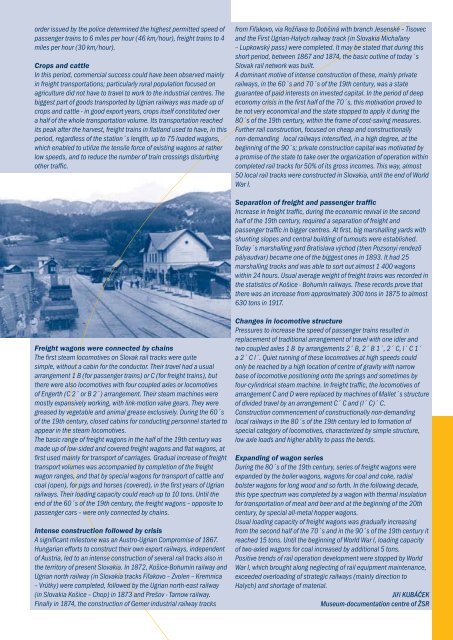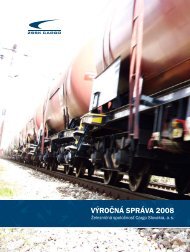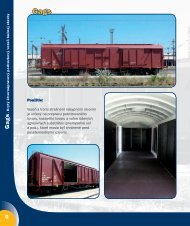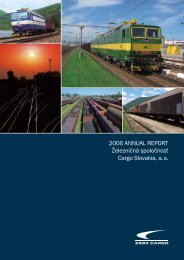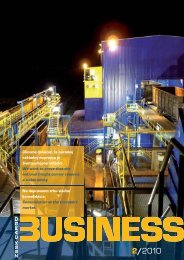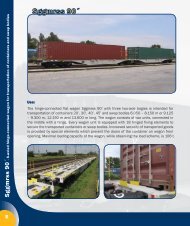CARGO BUSINESS 3-08.indd - ZSSK Cargo
CARGO BUSINESS 3-08.indd - ZSSK Cargo
CARGO BUSINESS 3-08.indd - ZSSK Cargo
- No tags were found...
Create successful ePaper yourself
Turn your PDF publications into a flip-book with our unique Google optimized e-Paper software.
order issued by the police determined the highest permitted speed ofpassenger trains to 6 miles per hour (46 km/hour), freight trains to 4miles per hour (30 km/hour).Crops and cattleIn this period, commercial success could have been observed mainlyin freight transportations; particularly rural population focused onagriculture did not have to travel to work to the industrial centres. Thebiggest part of goods transported by Ugrian railways was made up ofcrops and cattle - in good export years, crops itself constituted overa half of the whole transportation volume. Its transportation reachedits peak after the harvest, freight trains in flatland used to have, in thisperiod, regardless of the station´s length, up to 75 loaded wagons,which enabled to utilize the tensile force of existing wagons at ratherlow speeds, and to reduce the number of train crossings disturbingother traffic.from Fiľakovo, via Rožňava to Dobšiná with branch Jesenské – Tisovecand the First Ugrian-Halych railway track (in Slovakia Michaľany– Lupkowský pass) were completed. It may be stated that during thisshort period, between 1867 and 1874, the basic outline of today´sSlovak rail network was built.A dominant motive of intense construction of these, mainly privaterailways, in the 60´s and 70´s of the 19th century, was a stateguarantee of paid interests on invested capital. In the period of deepeconomy crisis in the first half of the 70´s, this motivation proved tobe not very economical and the state stopped to apply it during the80´s of the 19th century, within the frame of cost-saving measures.Further rail construction, focused on cheap and constructionallynon-demanding local railways intensified, in a high degree, at thebeginning of the 90´s; private construction capital was motivated bya promise of the state to take over the organization of operation withincompleted rail tracks for 50% of its gross incomes. This way, almost50 local rail tracks were constructed in Slovakia, until the end of WorldWar I.Separation of freight and passenger trafficIncrease in freight traffic, during the economic revival in the secondhalf of the 19th century, required a separation of freight andpassenger traffic in bigger centres. At first, big marshalling yards withshunting slopes and central building of turnouts were established.Today´s marshalling yard Bratislava východ (then Pozsonyi rendezőpályaudvar) became one of the biggest ones in 1893. It had 25marshalling tracks and was able to sort out almost 1 400 wagonswithin 24 hours. Usual average weight of freight trains was recorded inthe statistics of Košice - Bohumín railways. These records prove thatthere was an increase from approximately 300 tons in 1875 to almost630 tons in 1917.Freight wagons were connected by chainsThe first steam locomotives on Slovak rail tracks were quitesimple, without a cabin for the conductor. Their travel had a usualarrangement 1 B (for passenger trains) or C (for freight trains), butthere were also locomotives with four coupled axles or locomotivesof Engerth (C 2´ or B 2´) arrangement. Their steam machines weremostly expansively working, with link-motion valve gears. They weregreased by vegetable and animal grease exclusively. During the 60´sof the 19th century, closed cabins for conducting personnel started toappear in the steam locomotives.The basic range of freight wagons in the half of the 19th century wasmade up of low-sided and covered freight wagons and flat wagons, atfirst used mainly for transport of carriages. Gradual increase of freighttransport volumes was accompanied by completion of the freightwagon ranges, and that by special wagons for transport of cattle andcoal (open), for pigs and horses (covered), in the first years of Ugrianrailways. Their loading capacity could reach up to 10 tons. Until theend of the 60´s of the 19th century, the freight wagons – opposite topassenger cars – were only connected by chains.Intense construction followed by crisisA significant milestone was an Austro-Ugrian Compromise of 1867.Hungarian efforts to construct their own export railways, independentof Austria, led to an intense construction of several rail tracks also inthe territory of present Slovakia. In 1872, Košice-Bohumin railway andUgrian north railway (in Slovakia tracks Fiľakovo – Zvolen – Kremnica– Vrútky) were completed, followed by the Ugrian north-east railway(in Slovakia Košice – Chop) in 1873 and Prešov - Tarnow railway.Finally in 1874, the construction of Gemer industrial railway tracksChanges in locomotive structurePressures to increase the speed of passenger trains resulted inreplacement of traditional arrangement of travel with one idler andtwo coupled axles 1 B by arrangements 2´ B, 2´ B 1´, 2´ C, l´ C 1´a 2´ C l´. Quiet running of these locomotives at high speeds couldonly be reached by a high location of centre of gravity with narrowbase of locomotive positioning onto the springs and sometimes byfour-cylindrical steam machine. In freight traffic, the locomotives ofarrangement C and D were replaced by machines of Mallet´s structureof divided travel by an arrangement C´ C and (l´ C)´ C.Construction commencement of constructionally non-demandinglocal railways in the 80´s of the 19th century led to formation ofspecial category of locomotives, characterized by simple structure,low axle loads and higher ability to pass the bends.Expanding of wagon seriesDuring the 80´s of the 19th century, series of freight wagons wereexpanded by the boiler wagons, wagons for coal and coke, radialbolster wagons for long wood and so forth. In the following decade,this type spectrum was completed by a wagon with thermal insulationfor transportation of meat and beer and at the beginning of the 20thcentury, by special all-metal hopper wagons.Usual loading capacity of freight wagons was gradually increasingfrom the second half of the 70´s and in the 90´s of the 19th century itreached 15 tons. Until the beginning of World War I, loading capacityof two-axled wagons for coal increased by additional 5 tons.Positive trends of rail operation development were stopped by WorldWar I, which brought along neglecting of rail equipment maintenance,exceeded overloading of strategic railways (mainly direction toHalych) and shortage of material.Jiří KUBÁČEKMuseum-documentation centre of ŽSR


